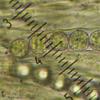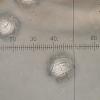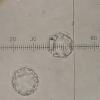
28-10-2025 19:33
 Nicolas Suberbielle
Nicolas Suberbielle
Bonjour à tous,Je voudrais votre avis sur cette r

31-10-2025 09:19
 Lothar Krieglsteiner
Lothar Krieglsteiner
Can somebody provide me with a file of:Rogerson CT

09-08-2025 13:13
 Maria Plekkenpol
Maria Plekkenpol
Hello,Yesterday I found these on burnt soil. Apoth

25-11-2016 13:54
 Stephen Martin Mifsud
Stephen Martin Mifsud
Hi, I found numerous seeds of Washingtonia robusta

28-10-2025 22:22
 Bernard Declercq
Bernard Declercq
Hello.I'm searching for the following paper:Punith

28-10-2025 15:37
Carl FarmerI'd be grateful for any suggestions for this strik
Lamprospora
Lothar Krieglsteiner,
24-08-2010 16:54
 in the Plitvicka jezera National park I found a small red discomycete I in the field considered to be a small Octospora or Lamprospora, only 3 apothecia in the vicinity of (cf.) Tortella tortuosa in a heathland on calcareous ground. The microscope said: a Lamprospora (spores round, with a distinct ornament of broken reticulate patterns)! But - the spores are too small for all species of the genus I became aware off. I measured 10-12 µm in living state, the spores are even smaller in my mount (that has become stained with cotton blue).
in the Plitvicka jezera National park I found a small red discomycete I in the field considered to be a small Octospora or Lamprospora, only 3 apothecia in the vicinity of (cf.) Tortella tortuosa in a heathland on calcareous ground. The microscope said: a Lamprospora (spores round, with a distinct ornament of broken reticulate patterns)! But - the spores are too small for all species of the genus I became aware off. I measured 10-12 µm in living state, the spores are even smaller in my mount (that has become stained with cotton blue).Do I miss something? Or what else is the solution? (Unfortunately I have taken no macrofoto).
Regards, Lothar
Raúl Tena Lahoz,
24-08-2010 21:03

Re:Lamprospora
Hi Lothar
Do you have a better microphoto showing the reticulate pattern?
Maybe it was as the one of my photos?
My species is Moravecia (Lamprospora) hvaleri. I find it next to cf Pleuridium acuminatum.
Associated to Tortella tortuosa (host moss) grows Lamprospora cailletii, but spores are bigger (14-15 without ornam. and 15-17 ornam. included) and the lipid body of the spore is 10-13 µm (Benkert´s data in his original description).
Cheers,
Raúl.
Do you have a better microphoto showing the reticulate pattern?
Maybe it was as the one of my photos?
My species is Moravecia (Lamprospora) hvaleri. I find it next to cf Pleuridium acuminatum.
Associated to Tortella tortuosa (host moss) grows Lamprospora cailletii, but spores are bigger (14-15 without ornam. and 15-17 ornam. included) and the lipid body of the spore is 10-13 µm (Benkert´s data in his original description).
Cheers,
Raúl.
Lothar Krieglsteiner,
24-08-2010 21:17

Re:Lamprospora
Dear Raul,
thank your very much for your posting. I have to have a closer look at the specimen. Can you tell me where Moravecia (Lamprospora) hvaleri is described, and who is the author, and what the spore dimensions are.
I cannot exclude Pleuridium acuminatum growing there (I know the moss, when it is fruiting).
Yours,
Lothar
thank your very much for your posting. I have to have a closer look at the specimen. Can you tell me where Moravecia (Lamprospora) hvaleri is described, and who is the author, and what the spore dimensions are.
I cannot exclude Pleuridium acuminatum growing there (I know the moss, when it is fruiting).
Yours,
Lothar
Raúl Tena Lahoz,
24-08-2010 21:59

Re:Lamprospora
Hi again Lothar,
The authorities are Dieter Benkert and Roy Kristiansen.
Moravecia hvaleri is described in Z. Mycol. 65 1999, p. 33-35: "Moravecia hvaleri und Kotlabaea trondii- zwei neue Pezizales-Arten aus Norwegen". Spore dimensions are 12-14 x 11-13 without ornamentation. I have found spores bigger (up to 15,5) but, as in all Octospora-Lamprospora, the variation from inmature to mature can be very high.
Recently, in 2007, Perry, Hansen & Pfister have found that Moravecia hvaleri is nested to the Lamprospora clade lineage in "A phylogenetic overview of the family Pyronemataceae (Ascomycota, Pezizales)".
Cheers,
Raúl.
The authorities are Dieter Benkert and Roy Kristiansen.
Moravecia hvaleri is described in Z. Mycol. 65 1999, p. 33-35: "Moravecia hvaleri und Kotlabaea trondii- zwei neue Pezizales-Arten aus Norwegen". Spore dimensions are 12-14 x 11-13 without ornamentation. I have found spores bigger (up to 15,5) but, as in all Octospora-Lamprospora, the variation from inmature to mature can be very high.
Recently, in 2007, Perry, Hansen & Pfister have found that Moravecia hvaleri is nested to the Lamprospora clade lineage in "A phylogenetic overview of the family Pyronemataceae (Ascomycota, Pezizales)".
Cheers,
Raúl.
Lothar Krieglsteiner,
24-08-2010 22:19

Re:Lamprospora
Dear Raul,
thank you very much for the information. I am sure now that my collection cannot be Moravecia hvaleri, for the following reasons: My collection has
- clear and large oil drops in the spores
- spores perfectly globose (not broadly ellipsoid) and even smaller as given for M. hvaleri
- the ornamentation does not fit pefectly
- I did not notice Pleuridium
Especially the first reason is severe I think.
Anyway, M. hvaleri seems to be the taxon coming closest to my fungus by now.
Thanks a lot for your help!
Lothar
thank you very much for the information. I am sure now that my collection cannot be Moravecia hvaleri, for the following reasons: My collection has
- clear and large oil drops in the spores
- spores perfectly globose (not broadly ellipsoid) and even smaller as given for M. hvaleri
- the ornamentation does not fit pefectly
- I did not notice Pleuridium
Especially the first reason is severe I think.
Anyway, M. hvaleri seems to be the taxon coming closest to my fungus by now.
Thanks a lot for your help!
Lothar





